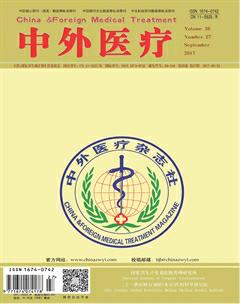妊娠期高血压疾病(HDP)患者子宫动脉及胎儿脐动脉血流动力学变化与结局的探讨
王莹+黄海鸣+鲁晓燕+刘颖蕾
[摘要] 目的 探討妊娠期高血压疾病(HDP)患者子宫动脉及胎儿脐动脉血流动力学变化的关系。方法 方便选取2015年1月—2016年6月在该院进行常规孕检的200例妊娠期高血压疾病(HDP)患者作为研究组,另选同一时间段内200名门诊和病房孕检产妇为对照组,2组患者均采用多普勒超声检查。比较2组患者血流动力学变化与胎儿情况及新生儿分娩结局的关系。结果 研究组患者子宫动脉PI(1.22±0.76)、RI(0.65±0.24)、S/D(29.04±0.18)明显高于对照组(P<0.05);胎儿脐动脉PI(0.92±0.07 )、RI(0.62±0.06)、S/D(2.35±0.09)明显高于对照组(P<0.05);研究组胎儿双顶径(9.04±0.54)cm、头围(29.04±0.18)cm、股骨长度(6.87±0.52)cm、腹围(29.60±1.86)cm;对照组胎儿双顶径(9.84±0.90)cm、头围(31.35±0.58)cm、股骨长度(7.58±0.46)cm、腹围(34.04±1.34)cm。研究组胎儿双顶径、头围、股骨长度等情况明显小于对照组(P<0.05);研究组新生儿结局情况与对照组相比较差异有统计学意义(P<0.05)。结论 妊娠期高血压不仅会影响母体子宫血液灌注情况,还会影响胎儿脐动脉血流量,严重阻碍胎儿宫内生长,必须尽早采取有效措施予以诊断与治疗。
[关键词] 妊娠期高血压疾病;子宫动脉;脐动脉;血流动力学
[中图分类号] R5 [文献标识码] A [文章编号] 1674-0742(2017)09(c)-0039-03
Study on Changes and Outcomes of Uterine Artery and Fetal Umbilical Artery Hemodynamics of HDP Patients
WANG Ying, HUANG Hai-ming, LU Xiao-yan, LIU Ying-lei
Department of Gynecology and Obstetrics, Nantong First Peoples Hospital, Nantong, Jiangsu Province, 226000 China
[Abstract] Objective To study the correlation between the uterine artery and fetal umbilical artery hemodynamics of HDP patients. Methods Convenient selection 200 cases of HDP patients with routine pregnancy examination in our hospital from January 2015 to June 2016 were selected as the research group, while 200 cases of outpatients and ward delivery women were selected as the control group, both groups adopted the colour Doppler ultrasound examiantion, and the changes of hemodynamics, fetal situation and delivery outcome of newborns were compared between the two groups. Results The uterine artery PI, RI and S/D in the research group were respectively (1.22±0.76), (0.65±0.24), (29.04±0.18), which were obviously higher than those in the control group(P<0.05), and the fetal umbilical artery PI, RI and S/D in the research group were respectively (0.92±0.07), (0.62±0.06),(2.35±0.09), which were obviously higher than those in the control group(P<0.05), and the fetal biparietal diameter, head circumference, femur length, abdominal perimeter in the research group were obviously lower than those in the control group, [(9.04±0.54)cm, (29.04±0.18)cm, (6.87±0.52)cm, (29.60±1.86)cm vs (9.84±0.90)cm, (31.35±0.58)cm, (7.58±0.46)cm,(34.04±1.34)cm](P<0.05); the difference in the newborns outcome situation between the research group and the control group was statistically signfiicant(P<0.05). Conclusion The hypertension during pregnancy can not affect the maternal uterus hemoperfusion but also affect the fetal umbilical artery blood flow and seriously prevent the fetal intrauterine growth, and we must adopt the effective measures for diagnosis and treatment as soon as possible.endprint

